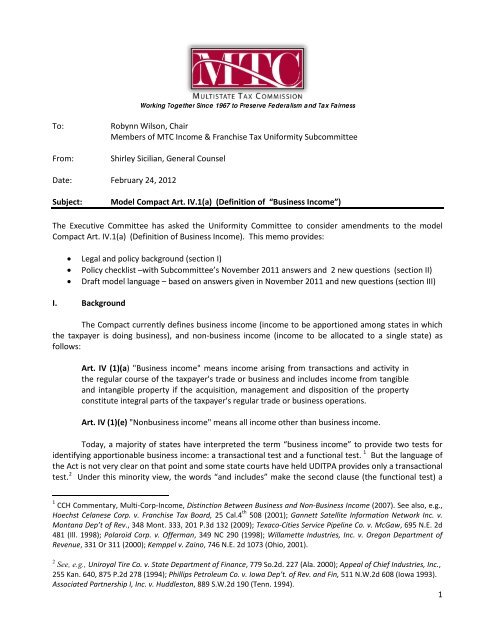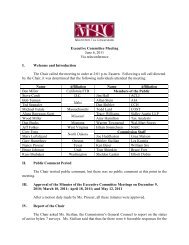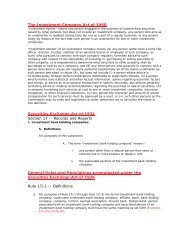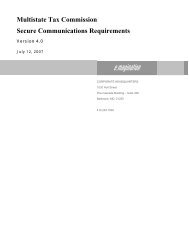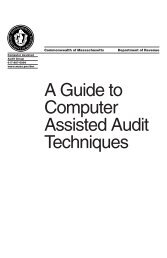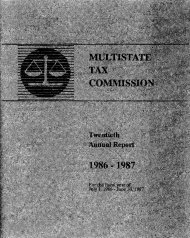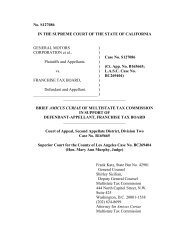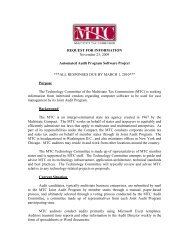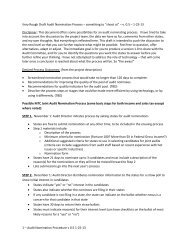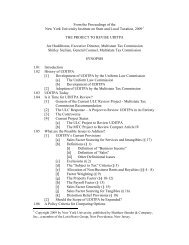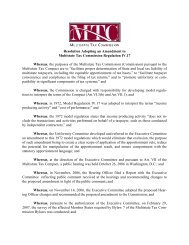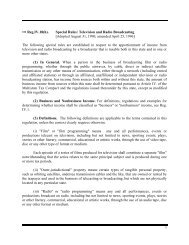Staff Memorandum and Draft Model Statute - Multistate Tax ...
Staff Memorandum and Draft Model Statute - Multistate Tax ...
Staff Memorandum and Draft Model Statute - Multistate Tax ...
You also want an ePaper? Increase the reach of your titles
YUMPU automatically turns print PDFs into web optimized ePapers that Google loves.
Working Together Since 1967 to Preserve Federalism <strong>and</strong> <strong>Tax</strong> Fairness<br />
To:<br />
From:<br />
Robynn Wilson, Chair<br />
Members of MTC Income & Franchise <strong>Tax</strong> Uniformity Subcommittee<br />
Shirley Sicilian, General Counsel<br />
Date: February 24, 2012<br />
Subject:<br />
<strong>Model</strong> Compact Art. IV.1(a) (Definition of “Business Income”)<br />
The Executive Committee has asked the Uniformity Committee to consider amendments to the model<br />
Compact Art. IV.1(a) (Definition of Business Income). This memo provides:<br />
• Legal <strong>and</strong> policy background (section I)<br />
• Policy checklist –with Subcommittee’s November 2011 answers <strong>and</strong> 2 new questions (section II)<br />
• <strong>Draft</strong> model language – based on answers given in November 2011 <strong>and</strong> new questions (section III)<br />
I. Background<br />
The Compact currently defines business income (income to be apportioned among states in which<br />
the taxpayer is doing business), <strong>and</strong> non-business income (income to be allocated to a single state) as<br />
follows:<br />
Art. IV (1)(a) "Business income" means income arising from transactions <strong>and</strong> activity in<br />
the regular course of the taxpayer's trade or business <strong>and</strong> includes income from tangible<br />
<strong>and</strong> intangible property if the acquisition, management <strong>and</strong> disposition of the property<br />
constitute integral parts of the taxpayer's regular trade or business operations.<br />
Art. IV (1)(e) "Nonbusiness income" means all income other than business income.<br />
Today, a majority of states have interpreted the term “business income” to provide two tests for<br />
identifying apportionable business income: a transactional test <strong>and</strong> a functional test. 1 But the language of<br />
the Act is not very clear on that point <strong>and</strong> some state courts have held UDITPA provides only a transactional<br />
test. 2 Under this minority view, the words “<strong>and</strong> includes” make the second clause (the functional test) a<br />
1 CCH Commentary, Multi-Corp-Income, Distinction Between Business <strong>and</strong> Non-Business Income (2007). See also, e.g.,<br />
Hoechst Celanese Corp. v. Franchise <strong>Tax</strong> Board, 25 Cal.4 th 508 (2001); Gannett Satellite Information Network Inc. v.<br />
Montana Dep’t of Rev., 348 Mont. 333, 201 P.3d 132 (2009); Texaco-Cities Service Pipeline Co. v. McGaw, 695 N.E. 2d<br />
481 (Ill. 1998); Polaroid Corp. v. Offerman, 349 NC 290 (1998); Willamette Industries, Inc. v. Oregon Department of<br />
Revenue, 331 Or 311 (2000); Kemppel v. Zaino, 746 N.E. 2d 1073 (Ohio, 2001).<br />
2 See, e.g., Uniroyal Tire Co. v. State Department of Finance, 779 So.2d. 227 (Ala. 2000); Appeal of Chief Industries, Inc.,<br />
255 Kan. 640, 875 P.2d 278 (1994); Phillips Petroleum Co. v. Iowa Dep’t. of Rev. <strong>and</strong> Fin, 511 N.W.2d 608 (Iowa 1993).<br />
Associated Partnership I, Inc. v. Huddleston, 889 S.W.2d 190 (Tenn. 1994).<br />
1
qualifying clause that serves to exemplify a certain type of income that is included only if it also fits within<br />
the first clause (the transactional test). In states where the courts found only a transactional test, the<br />
legislatures generally followed-up with a statutory amendment to clearly add the functional test. 3 There<br />
has also been a trend over the last few years to adopt legislation defining business income simply as all<br />
income apportionable under the U.S. Constitution. 4 In part, this trend is a reaction to court cases that<br />
found income from the sale of a business or its assets are not included under the UDITPA definition, even<br />
under the functional test, if the entire business is being liquidated. 5<br />
II.<br />
Policy Issues<br />
Policy Checklist with Subcommittee Answers Given November, 2011<br />
At its November 2011 meeting, the Uniformity Subcommittee answered a Policy Checklist developed by the<br />
<strong>Draft</strong>ing Group 6 as follows:<br />
1. Should “business income” include both a transactional <strong>and</strong> a functional test<br />
‣ YES<br />
2. If “business income” includes a functional test, should that test encompass income from<br />
cessation or liquidation of a business or line of business<br />
‣ YES<br />
a. Does it matter whether the transaction is a deemed liquidation under 338(h)(10) or an<br />
actual liquidation<br />
‣ NO<br />
b. Does it matter how the gains are used<br />
‣ NO<br />
3. Functional income is currently described as “income from tangible <strong>and</strong> intangible property if<br />
acquisition, management <strong>and</strong> disposition of property constitute integral parts of the taxpayer's<br />
regular trade or business operations.”<br />
a. Would it be clearer to state the test as “acquisition, management or disposition of<br />
property constitutes …”<br />
3 See, e.g.:<br />
Alabama: Ala. H.B. 7 (Dec. 28, 2001) amending Ala. Code Sec. 40-27-1.1 after Uniroyal Tire Co. v. State Department of<br />
Finance, 779 So.2d. 227 (Ala. 2000).<br />
Iowa: Iowa Code § 422.32 after Phillips Petroleum v. Iowa Dep’t of Rev. <strong>and</strong> Fin., 511 N.W. 608 (Iowa 1994).<br />
Kansas: K.S.A. 79- 3271(a) after Appeal of Chief Industries, Inc., 255 Kan. 640, 875 P.2d 278 (1994).<br />
Tennessee: T.C.A. § 67-4-2004 after Associated Partnership I, Inc. v. Huddleston, 889 S.W.2d 190 (Tenn. 1994).<br />
4 See, e.g.:<br />
Illinois: 35 ILCS 5/1501(a)(1); Kansas: K.S.A. 79-3271(a); Minnesota: Minn. Stat. §290.17 Subd.4.(a); North Carolina:<br />
N.C. Gen. Stat. §105-130.4(a)(1); Pennsylvania: 72 P.S. §7401(3)2.(a)(1)(A).<br />
5 Lennox v. Tolson, 353 N.C. 659 (2001); Laurel Pipe Line Co. v. Commonwealth of Pennsylvania Board of Finance <strong>and</strong><br />
Revenue, 537 Pa. 205(1994); Kemppel v. Zaino, 746 N.E. 2d 1073 (Ohio, 2001); Blessing/White, Inc. v. Zehnder, 329<br />
Ill.App.3d 741 (2002).<br />
6 The drafting group includes Ben Miller <strong>and</strong> Melissa Potter (CA- FTB), Ted Spangler (ID), Gary Humphrey, Janielle<br />
Lipscomb, <strong>and</strong> Jeff Henderson (OR), Michael Fatale (MA), Joe Garrett <strong>and</strong> Holly Coon (AL), <strong>and</strong> Commission <strong>Staff</strong><br />
Shirley Sicilian <strong>and</strong> Bruce Fort. The drafting group has been regularly joined by Wood Miller (MO), Donnita Wald <strong>and</strong><br />
Mary Loftsgard (ND), <strong>and</strong> Phil Horwitz (CO).<br />
2
‣ YES<br />
b. Should other terms be included, such as “employment” <strong>and</strong> “development”<br />
‣ Employment – Yes; Development – Yes<br />
c. Both the transactional <strong>and</strong> functional tests use the word “regular.” Is it clear that<br />
"regular" does not limit the functional test to frequent events, or does this need to be<br />
clarified The California Supreme Court explained in Hoechst Celanese: “In the<br />
transactional test—which focuses on the income-producing transaction—‘regular’<br />
modifies ‘course of the taxpayer's trade or business’ <strong>and</strong> makes the nature of the<br />
transaction relevant. In the functional test—which focuses on the income-producing<br />
property— ‘regular’ modifies ‘trade or business operations’ <strong>and</strong> follows the phrase ‘an<br />
integral part of.’ Consequently, ‘regular,’ as used in the functional test, does not refer<br />
to the nature of the transaction, <strong>and</strong> the extraordinary nature or infrequency of the<br />
income-producing transaction is irrelevant.” Could the term “regular” be eliminated<br />
from the functional test<br />
‣ YES, Eliminate “regular” from functional test.<br />
d. The term "integral" is the touchstone for determining whether property has a close<br />
enough relationship to the taxpayer to satisfy the functional test. But is the term clear<br />
or is it needlessly vague In Hoechst Celanese, the California Supreme Court explained<br />
that interpreting “integral” as “contributing to” could be unconstitutionally broad,<br />
while interpreting “integral” as “necessary to” or “essential to” would be too restrictive<br />
(since no asset would be sold if it were necessary or essential). The Court found that<br />
“integral” should be construed somewhere between these two – e.g., “materially<br />
contributing to.” Another option would be to use the language of the U.S. Supreme<br />
Court in Allied Signal <strong>and</strong> require that the property from which the income arises is<br />
“operationally related to” or “related to the operation of” the taxpayer’s business.<br />
‣ NO, but the vote was so close that the drafting group included language, for<br />
consideration.<br />
e. Should “tangible <strong>and</strong> intangible property” be replaced with “property or assets”<br />
‣ NO<br />
4. If “business income” includes both functional <strong>and</strong> transactional tests, <strong>and</strong> includes gain/loss<br />
from cessation of business,<br />
a. Is the intent to encompass all income apportionable under the U.S. Constitution<br />
‣ YES<br />
b. If so, should that be stated in the statute Tying the statutory definition to the scope of<br />
the constitution is not very specific guidance, <strong>and</strong> may introduce some additional<br />
uncertainty, on the one h<strong>and</strong>. On the other h<strong>and</strong>, the absence of such a statement<br />
could result in an interpretation that is something short of the constitutional scope. Is<br />
the more important goal increased clarity or full apportionment<br />
‣ YES, but instead of “to the extent,” use a phrase that sounds less like a limitation,<br />
such as “all income apportionable under.”<br />
c. Would it be useful to retitle “business income,” e.g., as “apportionable income” or<br />
“unitary income”<br />
‣ MAYBE; Review UDITPA<br />
3
5. Is it necessary for the statutory definition to explicitly anticipate the potential for a single<br />
taxpayer to operate more than one “trade or business” Or, because that concept is a<br />
constitutional requirement, is it sufficient that that it be addressed, as it is now, in regulation<br />
‣ NO<br />
New Policy Questions<br />
6. Income arising from a taxpayer’s assets or investments that are not a part of the taxpayer’s<br />
unitary business may constitutionally be allocated directly to the state where the asset is<br />
located or the taxpayer is domiciled. 7 But that state is certainly not required by the<br />
constitution to tax all of this non-unitary income, <strong>and</strong> may constitutionally apportion it, instead.<br />
Should a qualification be added to clarify that “all income that is apportionable under the<br />
Constitution…” does not include non-unitary income which would otherwise be allocable to this<br />
state<br />
7. Some states have chosen to apportion certain types of non-unitary income that would<br />
otherwise be allocable to the state. Should a provision be added to clarify that these types of<br />
income are to be included in “business income” <strong>and</strong> thus apportioned accordingly<br />
II.<br />
<strong>Draft</strong> Language<br />
The <strong>Draft</strong>ing Group developed these amendments to reflect the Subcommittee’s policy direction given in<br />
November, 2011. The draft also reflects the clarifications discussed in questions 6 <strong>and</strong> 7.<br />
Art. IV (1)(a) “Business income” means:<br />
(i) all income that is apportionable under the Constitution of the United States <strong>and</strong> is<br />
not allocated under the laws of this state, including:<br />
(A) income arising from transactions <strong>and</strong> activity in the regular course of the<br />
taxpayer’s trade or business, <strong>and</strong> includes<br />
(B) income arising from tangible <strong>and</strong> intangible property if the acquisition,<br />
management, employment, development, or disposition of the property<br />
constitute integral parts of is or was related to the operation of the taxpayer's<br />
regular trade or business operations; <strong>and</strong><br />
(ii) any income that would be allocable to this state under the Constitution of the<br />
United States, but that is apportioned rather than allocated pursuant to the laws of<br />
this state.<br />
AND:<br />
Art. IV (1)(e) "Non-business income" means all income other than business income.<br />
7 See Compact Art.IV.4 – 8. See Whitney v. Graves, 299 U.S. 366 (1937) (New York could impose income tax<br />
on out-of-state resident’s capital gain from sale of New York stock exchange membership). See also, Allied-<br />
Signal v. Director, Div. of <strong>Tax</strong>., 504 U.S. 768, 778 (1992); Exxon Corp. v. Wisconsin, 447 U.S. 207, 229 (1980).<br />
4


